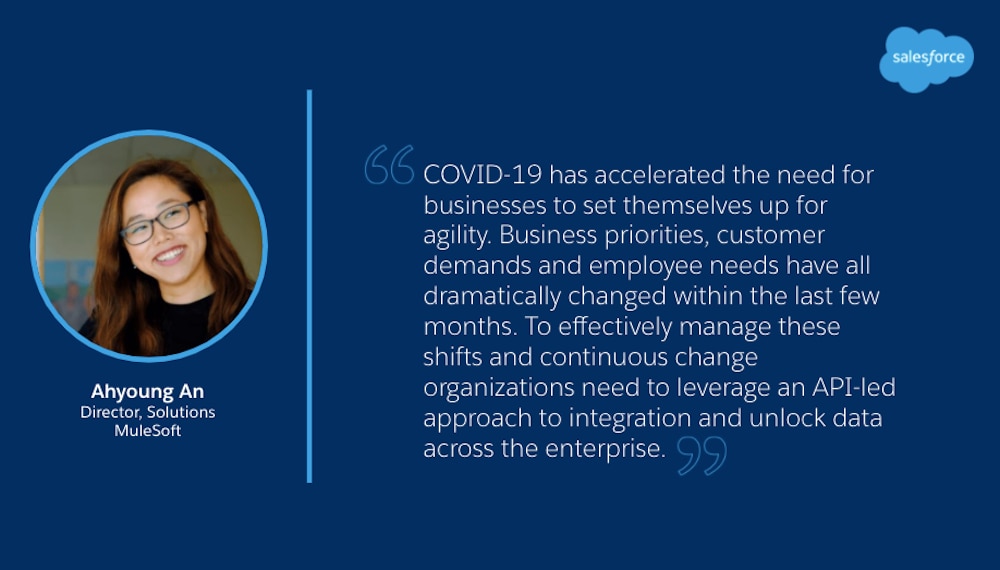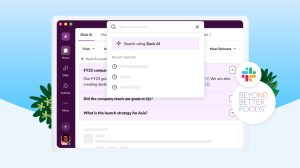As part of an expanded partnership announced in May, Salesforce and Workday will offer integrated solutions to help organizations prepare for a return to work. To help organizations make critical return-to-work decisions and respond to COVID-19 faster, MuleSoft and Workday are also empowering organizations to unlock data across systems and act on insights faster through Work.com.
Today, MuleSoft is announcing a new MuleSoft Accelerator for Work.com to arm leaders with integration tools to quickly and easily import and synchronize the employee data needed to inform safe return to work strategies. When paired with Workday Human Capital Management (HCM), joint customers can access data to safeguard and support the workforce and align talent for a changing world of work.
COVID-19 has challenged leaders across organizations to move at an unprecedented pace and make mission-critical decisions that affect customers, employees and the wider community. To guide those decisions and quickly act on them, businesses need the ability to leverage employee data residing in different applications to protect employees as they reopen offices in compliance with local health and safety regulations.
Available now, MuleSoft Accelerator for Work.com allows customers to easily integrate data from any system into the suite of solutions. MuleSoft Accelerator for Work.com provides pre-built connectors, integration templates, and data mappings to unlock critical employee data from systems like Workday to enhance Work.com products like the Workplace Command Center, Contact Tracing, and Shift Management to do what matters most — get employees back to work safely. For MuleSoft and Workday HCM customers, the MuleSoft Accelerator for Work.com will be provided at no additional cost.
To help us better understand the partnership between Salesforce and Workday and why unlocking employee data is so important to creating safe return to work strategies we recently sat down with Ahyoung An, Director of Solutions, MuleSoft and David Somers, GM, Talent Optimization, Workday to learn more.
Ahyoung An is the Director of Solutions for MuleSoft, responsible for bringing productized solutions to market that accelerate the impact of a customer’s application network. David Somers is the GM of Talent Optimization at Workday, responsible for leading the strategy and development of HCM products.
Q: What types of decisions can leaders now make with Workday data integrated into Work.com?
“With employee data available in Work.com, business and HR leaders can quickly and easily understand how employees are doing, if they’ve been exposed to COVID-19, and if not, how to safely bring them back to work,” said Ahyoung An, Director of Solutions, MuleSoft. “By leveraging Workday data across Contact Tracing and Shift Management capabilities in Work.com employers can quickly understand which team members may be exposed to the virus if an employee gets sick and mitigate exposure with a thoughtful approach to office density.”
“As the single source for data for organizations related to their workforce, Workday HCM provides the critical worker data to help make important business decisions as they respond to the global pandemic,” David Somers, GM, Talent Optimization, Workday. “By combining Work.com’s Shift Management and Contact Tracing with employee sentiment, health attestation, and work location preferences through Workday surveys, leaders can have confidence in their plan, supported by data-driven decisions about who returns to the workplace, where they can safely return, and how the work gets done.”
Q: Why is it so important to unlock employee data to reopen offices and businesses safely?
“Crafting a return to work strategy will be unique to each business and their office footprint. To navigate this complexity businesses need to understand local and state public health guidance, up to date information on COVID-19 cases and what cities employees are commuting from and to which offices. If COVID-19 cases are spiking in a specific city, business leaders should consider limiting the movement of employees living in those towns to office locations until cases return to a manageable level,” said An.
“From a worker perspective the return to work will be a very personal decision. Living and commuting situations, their own health, the health of colleagues, and work location preferences will impact their willingness or ability to return to the workplace. So not only is a return to the workplace strategy unique to each business and office location, it is also unique to each worker. An understanding of employee sentiment, workforce, and workplace data will allow HR partners and people leaders to respond with empathy, ensure safety and wellbeing, and enable productivity,” said Somers.
Q: How can HR partners lead through change and uncertainty with data?
“HR partners must navigate the current environment by putting people at the center of their response strategy. Real-time data about employee preferences and health will enable HR leaders to adapt quickly to health and safety concerns. In addition, organizations need a clear understanding of workforce skills and business needs to adjust talent acquisition plans, create agile teams, and redeploy or reskill talent for an effective recovery strategy. Transparency during all phases of the response is important for employee morale, organizational health, and productivity,” said Somers.
Q: How can Work.com help organizations navigate a phased approach to reopening?
“Understanding worker’s health status, work location preferences, site capacity, and local COVID-19 trends will inform a phased reopening. To support the reopening, customers can deploy announcements, micro-curated learning content, and digital worker journeys to communicate critical information and expectations and provide transparency, support, and guidance,” said Somers.
“Organizations need to think about reopening phases at the macro and local level. For example, a retailer may decide that they are ready and able to implement curbside pickup. However, which locations they decide to open and when they open should be informed by how local COVID-19 cases are growing or declining. To effectively reopen businesses need the ability to conduct manual contact tracing across employees, monitor employee wellness and orchestrate shifts to avoid large gatherings at physical locations. All of these capabilities are available in Work.com,” said An.

Q: As companies stabilize and look towards growth how should they think about leveraging employee skill sets to reskill the workforce and maintain agility in addressing business and customer needs?
“The continued uncertainty related to the pandemic will require ongoing organizational flexibility. Clarity about workforce skills and capabilities will allow organizations to focus on organizational modeling, talent planning, recruiting, learning, career development, and gig-based assignments to reskill and redeploy their workforce. Workday’s Skills Cloud foundation provides real-time insight into what skills and capabilities an organization has and what they need, allowing them to effectively engage their workforce to achieve rapidly changing business goals and to address customer needs,” said Somers.
“COVID-19 has accelerated the need for businesses to set themselves up for agility. Business priorities, customer demands and employee needs have all dramatically changed within the last few months. To effectively manage these shifts and continuous change organizations need to leverage an API-led approach to integration and unlock data across the enterprise. By creating a composable enterprise, where business capabilities can be leveraged as building blocks to create experiences with APIs, companies can quickly bring new products and services to their customers at the speed of market change, leverage the right talent for critical projects and keep employees engaged,” said An.



















